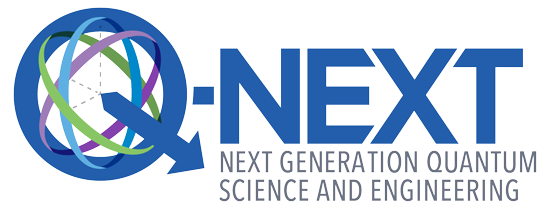If you’re setting out to help build a new kind of communication network that will one day crisscross the country, it’s good to have the perspective of a company who has a successful track record.
The largest wireless carrier in the United States, Verizon, a Q-NEXT partner, is assessing how to scale the center’s science for practical applications.
“We bring that experience of understanding how to deploy technology at scale in a carrier network, which will be critical for Q-NEXT and its focus on quantum communication,” said Jean McManus, executive director of applied research at Verizon. “If you’re a university researcher, you’re typically used to working in fairly small-scale environments. We understand how to scale networks, and we understand how to evolve networks with new technology.”

Verizon currently manages over one million miles of telecommunication fiber in the ground. Their understanding of the telecommunication landscape, at the level of both infrastructure and devices, provides the commercial, practical and large-network lens that will facilitate Q-NEXT’s laying the groundwork for a quantum internet.
“Verizon’s role in Q-NEXT is vital,” said Q-NEXT Director David Awschalom. “Their broad knowledge of communication networks and deep understanding of relevant quantum technologies means we can identify emerging opportunities early in the R&D process, accelerating the development of a robust quantum internet.”
If, for example, Q-NEXT researchers were looking to develop a prototype for a quantum repeater to be deployed in a metropolitan-scale network, they could look to Verizon to share the requirements that need to be integrated.
“There’s this whole other side that you have to worry about once you get everything in the R&D lab stable,” McManus said. “You then need to think about how to transition it so it can be used in a product or service by a carrier.”
A major effort will be integrating new quantum devices into existing fiber networks.
“With the quantum internet, you’re not going into a greenfield environment,” McManus said. “We’re sorting through how the classical internet and the quantum internet would play together, how it would fit into an environment that already has a backbone and regional networks.”
The vision of one day realizing a quantum network drives Verizon’s diverse interest in quantum technology, including quantum communication, security, sensing and computing.

Verizon has been working to advance quantum security through technologies such as quantum-safe VPN, which could replace current encryption methods. And last year, Verizon became one of the first carriers in the U.S. to pilot quantum key distribution, another quantum-security technology.
Verizon is also exploring quantum sensing use cases, such as sensors for navigation, as well as applications for quantum computers, such as solving optimization problems that could be useful for the company.
“We know that’s just the tip of the iceberg, and we know that people are going to be super creative once those computers come full-bore,” McManus said.
McManus appreciates how, complementary to Verizon’s carrier perspective on networking requirements, Q-NEXT’s quantum scientists and engineers provide basic-research perspectives, which will be valuable for Verizon.
“Where I see benefit to Verizon is access to Q-NEXT researchers. They’re just phenomenal,” she said. “We are so excited about the great work they’re doing and the ability to have early access to them so we can better understand what’s coming.”
In addition to connecting with world-class quantum scientists and engineers, McManus looks forward to connecting Q-NEXT students with Verizon.
“Over time, they may be looking for professional opportunities, so it gives us a foot in the door to recruit,” she said.
Verizon collaborators are also contributing to Q-NEXT’s quantum technology roadmap, which outlines the research and scientific discoveries needed for the distribution of quantum entanglement, especially for impactful progress in quantum computing, communications and sensing technology, on a 10- to 15-year timescale.
“We’re going to learn so much in the coming years, to find ways to use this technology that no one’s even thinking about right now,” McManus said. “What’s exciting is the possibility of the unknown.”
This work was supported by the DOE Office of Science National Quantum Information Science Research Centers.
